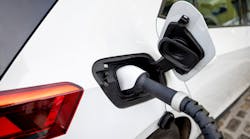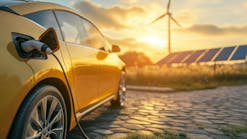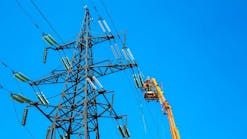The job of electric utilities is tough. Because storing electricity can be costly, utilities and grid operators must perfectly match supply and demand every second of the day, otherwise blackouts ensue, and billions of dollars of infrastructure could be damaged. Extreme weather events, increasing levels of renewable adoption, and growing demand due to electrification are fundamentally making utilities’ job even more difficult.
Electric vehicles (EV) are a major part of the energy transition—the force behind decarbonization and the defining problem of this century—but they’re not being adopted fast enough. The transportation sector accounts for nearly 30% of US greenhouse gas emissions, and EVs are primed to be the major solution.
Smart charging—the practice of intelligently managing and controlling charging speeds and schedules—is the technology that can both help utilities more easily transition and accelerate EV adoption.
What is Smart Charging?
Smart charging encompasses a wide range of strategies that shift, modulate, and control charging schedules to alleviate grid stress and reduce costs for drivers. These strategies can be broken down into three categories: managed uni-directional charging (grid-to-vehicle, or V1G), bi-directional charging/discharging (vehicle-to-grid, or V2G), and user-managed charging (UMC). Figuring out the proper smart charging strategy depends on utility constraints and driver needs. Further, smart charging doesn’t always need to rely on physical charging infrastructure; it can also be implemented using telematics that control charging times and speeds from within the vehicle.
For utilities, demand from EV charging can reverse stagnating energy demand—driven by decades of energy-efficiency improvements across sectors—into a multibillion dollar opportunity by increasing energy use and revenue. Many are concerned that EV demand will be a major grid problem, but these concerns are over-stated. California, the largest EV market in the world, has over 1 million EVs on the road but charging demands account for only 0.4% of peak-load. With 5.4 million EVs and 193,000 electrified commercial trucks projected to be on California roads by 2030, this would still only account for 4% of California peak-demand. A report from Pacific Northwest National Labs found that the nation could electrify add nearly 200 million EVs to the road solely through proper management of EV charging, without the need for introducing new capacity.
This is all good news, because supply chain issues are currently causing multi-year backlogs on critical distribution grid infrastructure, creating more need for efforts that delay grid upgrades. When combined with other electrification efforts, smart charging can delay grid upgrades by flattening peak demand, with the added benefit of reducing retail rates. But because a driver’s decision to charge their EV depends so heavily on charging time, reliability, and cost, smart charging should prioritize improving drivers’ experience while balancing grid needs.
Benefits of Smart Charging by Driver Segment
Ask any friend or family member about why they have reservations about buying an EV and you will hear concerns about limited charging infrastructure. It’s no secret that the lack of available, accessible, and reliable charging infrastructure is a major roadblock that is putting the brakes on EV adoption. What’s less known is how smart charging is already improving EV user experience and grid management across 5 key driver segments: residential, retail and destination, fleet depots, workplace, and on-the-go. Each segment has distinct charging patterns and driver behavior including where, when, how much, and how fast drivers will charge. As such, different smart charging strategies should be deployed for each segment to leverage parked vehicles that sit unused for an average 23 hours a day.
Residential charging currently accounts for about two-thirds of all EV charging, and has seen successful applications of all three smart charging categories. The simplest UMC strategy is time-of-use (TOU) tariffs set by utilities—which is widely used in California and increasingly adopted by other states—but this still requires drivers to schedule their charging accordingly. TOU tariffs set varying electricity rates depending on the time of day to incentivize consumers to shift EV charging to hours when the grid is not stressed, and therefore when electricity is cheaper. Managed uni-directional V1G charging in studies have shown that up to 63% of charging can be shifted to off-peak hours, saving consumers and utilities money.
Finally, V2G technology, though newer and less proven, has garnered widespread interest for home backup power capability, as evidenced by the high demand for Ford’s F150 Lightning with backup power capability, one of the first EVs to hit the road with this feature. However promising, residential access to chargers remains a luxury available to homeowners—typically urban residents with higher incomes in predominantly white neighborhoods—while residents with street-only parking or renters without in-unit chargers must rely on public networks.Retail and Destination locations, like Starbucks and National Parks, are installing EV chargers to increase accessibility but are struggling to determine how to do this cost-effectively. These locations often have demand charges included in their utility bill—a cost associated with peak power draw from the facility over the course of the month—which can run as high as 50-90% of the total month’s end utility bill. By throttling and modulating charging control speeds at these locations with V1G technology, retailers can still benefit from bringing in EV customers while maintaining or reducing the demand charges in their utility bills. Smart charging can therefore further increase accessibility by enabling utilities to install chargers in more locations.
Fleet Depots, or groups of vehicles managed by one entity, are perhaps the most promising sector to deploy a range of smart charging strategies. Fleet vehicles have routine charging schedules, predictable energy load, and are controlled by a fleet operator that can reach large savings with minimal disruption. V1G capability can significantly reduce the demand charges incurred by fleet EVs that often show up on operators’ utility bills, and new tariffs are already being designed that further incentivizes fleet depots to limit their peak demand.
With such predictable charging schedules, fleet depots are also beginning to implement V2G pilot projects to further reduce costs and support utilities during times of emergency. In California, the Emergency Load Reduction Program (ELRP)—already credited with avoiding rolling blackouts during wildfires and extreme weather events—can earn voluntary customers $2 per kWh for any energy they offset. This rate is 10 times more expensive for utilities than their typical supply cost but, nonetheless, is valuable during emergencies. Importantly, any voluntary participants can opt-out of these utilities’ requests for support, which typically only occur 1-3 times per year, in case drivers need to preserve their vehicles’ state-of-charge. Finally, these smart charging benefits at fleet depots can be supplemented with on-site battery storage systems or on-site solar to further alleviate EV load and increase consumers’ savings.
Workplace charging predominately happens during daytime hours when solar output is high and, in California at least, electricity prices are low. By having managed uni-directional smart charging stations, EV load can be shifted to these solar producing hours, which can lead to substantial cost savings and increased grid reliability from lowering peak demand. Throttling and modulating charging control speeds could allow existing electrical distribution infrastructure to support over 67% more cars than under uncontrolled charging scenarios. Further, for critical workplaces and infrastructure—like schools and hospitals—V2G pilot projects have also been used for backup power needs to improve resilience during or after emergencies.
On-the-go drivers rely on fast-charging infrastructure to recharge their car as quickly as possible, reaching refuel times of less than 20min in some cases. While on-the-go charging comprises roughly 10% of overall charging, a small fraction of the overall share, potential EV buyers’ significant range anxiety makes increasing the accessibility of fast-chargers disproportionately paramount for broad EV adoption. Unfortunately, the fast-charger sector is plagued by low profitability and poor customer experience. High upfront costs during installation, reaching $150,000 in some cases, are prohibitively expensive, and upfront tax credits paired with low profitability leads to on-going reliability issues.
The cash generated from fast-chargers are often insufficient to recoup these installation and operation costs, especially considering that many have low utilization rates and high downtime. This is partly due to poor customer experience at fast-charger stations outside of the Tesla network, where customer ratings have shown mediocre marks for reliability, charging speeds, availability, and finding chargers. More sophisticated smart charging strategies that give drivers options for charging speeds, flexibility, and price can help accelerate this sector and improve customer experience.
A Strong Future
The EV industry is filled with many stakeholders with competing interests: utilities want to maintain reliability, drivers want inexpensive charging access, governments want to decarbonize while becoming more energy independent, and businesses want to capitalize on a growing market. Smart charging, through its range of charging strategies and targeted customer segments, has the potential to align these stakeholders and provide win-win scenarios for everyone.
Jonathan Roth, PhD is an energy and utilities advisor at PA Consulting and a 2022 National Fellow with the Clean Energy Leadership Institute.


